Leg Pain Stretching Exercises
Leg mobility exercises.
Flexibility routine for pain in glutes, hamstrings, knees and calves.
Leg mobility exercises.
Flexibility routine for pain in glutes, hamstrings, knees and calves.
This leg stretching and flexibility program comprises a series of exercises designed to help you reduce tightness and improve movability. Shortened hamstrings and fascia can lead to knee or leg pain. In most cases, age, bad posture, and long periods of sitting cause your muscles to get shorter and less elastic. We provide you with leg stretching exercises that can help you heal your pain.
All of those exercises can easily be done at home within a few minutes. It is important to start slowly and gradually increase the intensity of the leg pain stretches as your flexibility improves. Follow our program and help your leg pain!
LEG stretching mobility exercises
Do your legs start hurting when you walk? Does the pain wake you up in the night? Do you feel an uncomfortable sensation when sitting or lying down? All these symptoms do not necessarily mean that there is anything wrong with you or your legs. In many cases, leg pain can be treated with a few simple and easy-to-learn stretching exercises.
Follow Jo's leg pain stretching routine on video or set your own pace by using our photo instructions below.
Leg stretching exercises improve leg mobility and flexibility by elongating the muscles and tendons, reducing muscle tension, improving circulation, and promoting relaxation.
It also helps improve our overall posture. There is no doubt that mobility make our 'everyday life' easier!
Stretching can help to reduce stress and improve overall well-being, cause when we are stressed, our muscles tend to tense up.
Stretching exercises also help o increase blood flow to the muscles, which brings more oxygen and nutrients.
Just like exercising in generel, stretching can promote the release of endorphins, which can help to improve mood.
Our body has the ability to heal itself if provided with the right circumstances. Leg stretching exercises reduce muscle tension which then can help to improve joint function and healing.
In some cases, this can, for example, lead to a reduction in knee pain. By activation the right muscles, our body is able to increase blood flow in the damaged areas and fasten the healing process.
Before beginning any exercises provided on this website, it is advised to consult a health professional, such as a physical therapist or chiropractor.
The exercise instruction and advice presented are in no way intended as a substitute for medical consultation. As with any exercise program, if at any point during your workout you begin to feel faint, dizzy, or have physical discomfort, you should stop immediately and consult a physician or doctor.
workouts
Total Exercise Time
workout mat
chair
stretch band or belt
STEP 1
Sit down on a chair or whatever you feel comfortable sitting on. It is important that you can lean your body forward when stretching tight glute muscles.
STEP 2
Bring your left leg up and place your ankle on your right knee, to begin with. The closer you can bring your ankle toward your body, the better.
Rest your forearms on your left knee and use them to push your leg down for some extra stretch. Now start leaning your upper body forward and feel the stretch in your glutes. Keep this position for around 45 seconds.
STEP 3
Now on to the other side. This time, bring your right leg up and place your ankle on your knee. The closer you can bring your ankle toward your body, the better.
If you want, you can use your forearms to push down your right knee. Lean your upper body forward and feel the stretch in your glutes. Keep this position for around 45 seconds.
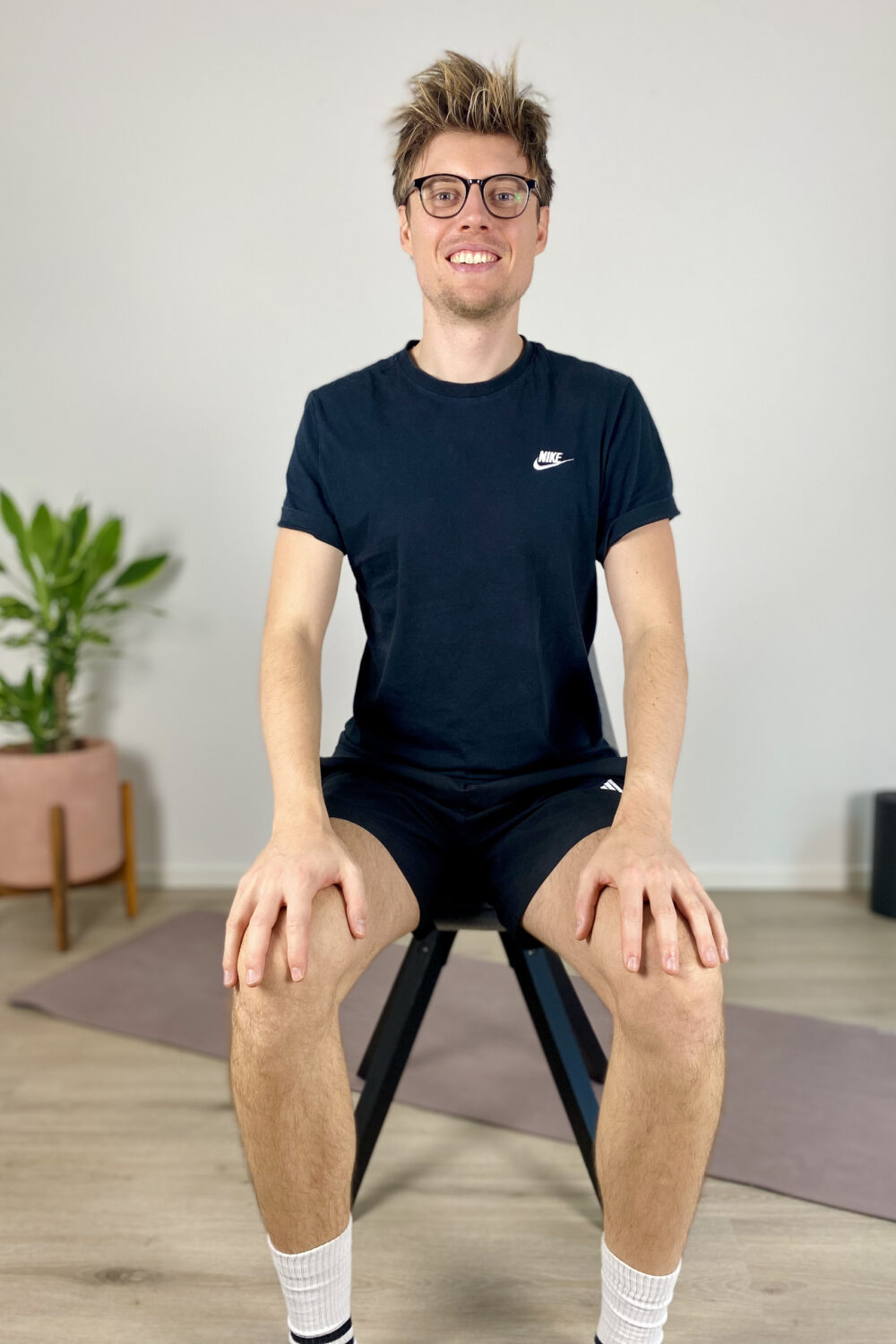

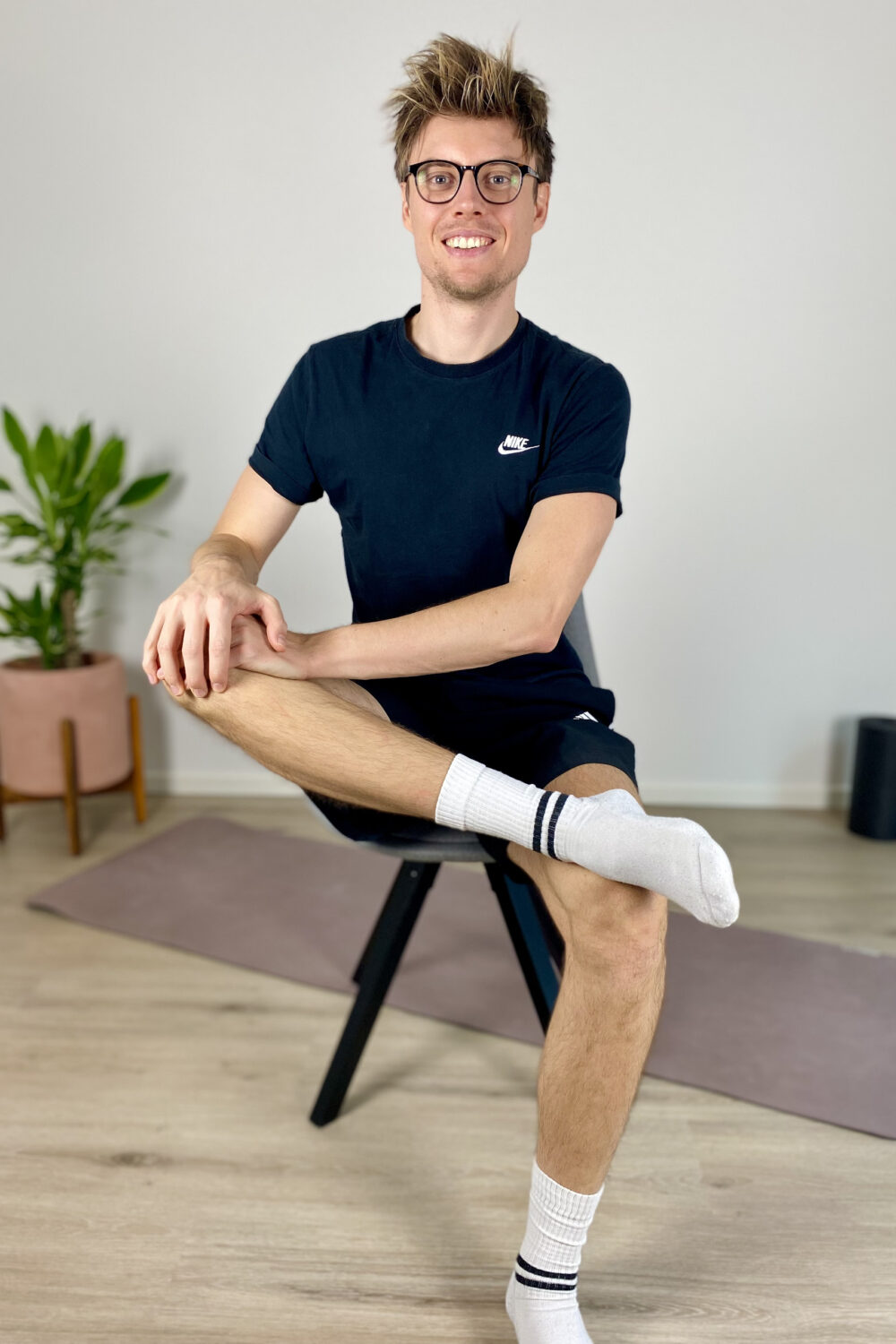
STEP 1
Get down on the floor and sit with your legs straight out in front of you.
Loop your band around your right foot. Grab onto each side with both hands and start pulling towards you.
Keep your leg as straight as possible. Your knee should touch the floor at all times.
Gently lean forward with your upper body and build up a nice stretch in the backside of your right leg.
STEP 2
Repeat the same exercise with your left leg.
If you want to intensify the stretch even more, you can put the floor of your other leg on your knee. This makes sure that your knee is as close to the ground as possible.
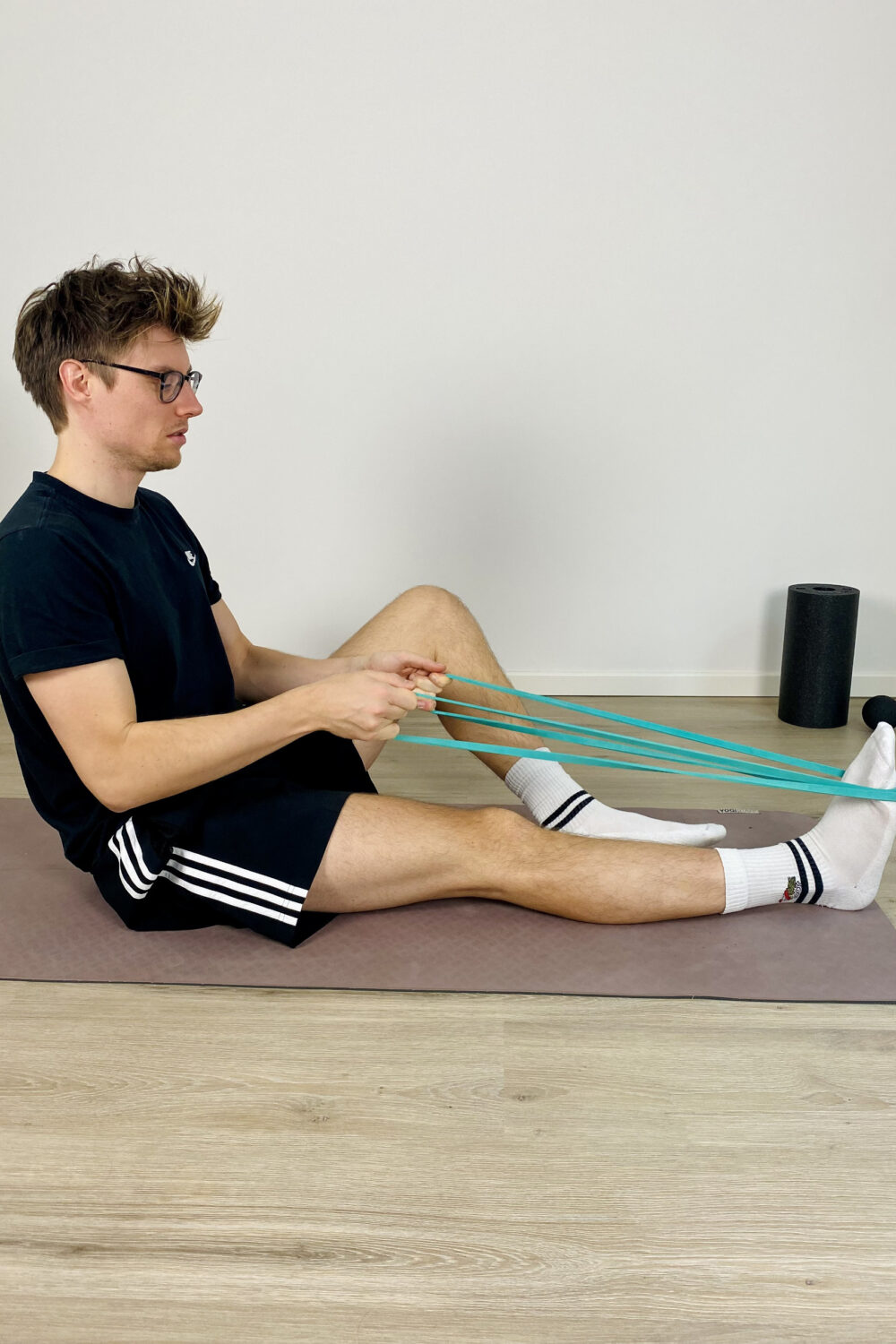

STEP 1
Lie down on your stomach. Use a sports mat, a towel or something soft if your floor is too hard.
Put your arms next to your body as if you want to do push-ups.
STEP 2
Push up your upper body with your arms, keeping your elbows locked and extended.
Push your groins and hips toward the ground. Keep flexing your glutes and lower back for extra support.
Stretch your hip flexors in this position for about 1 minute.
Be careful not to go into a hollow back.
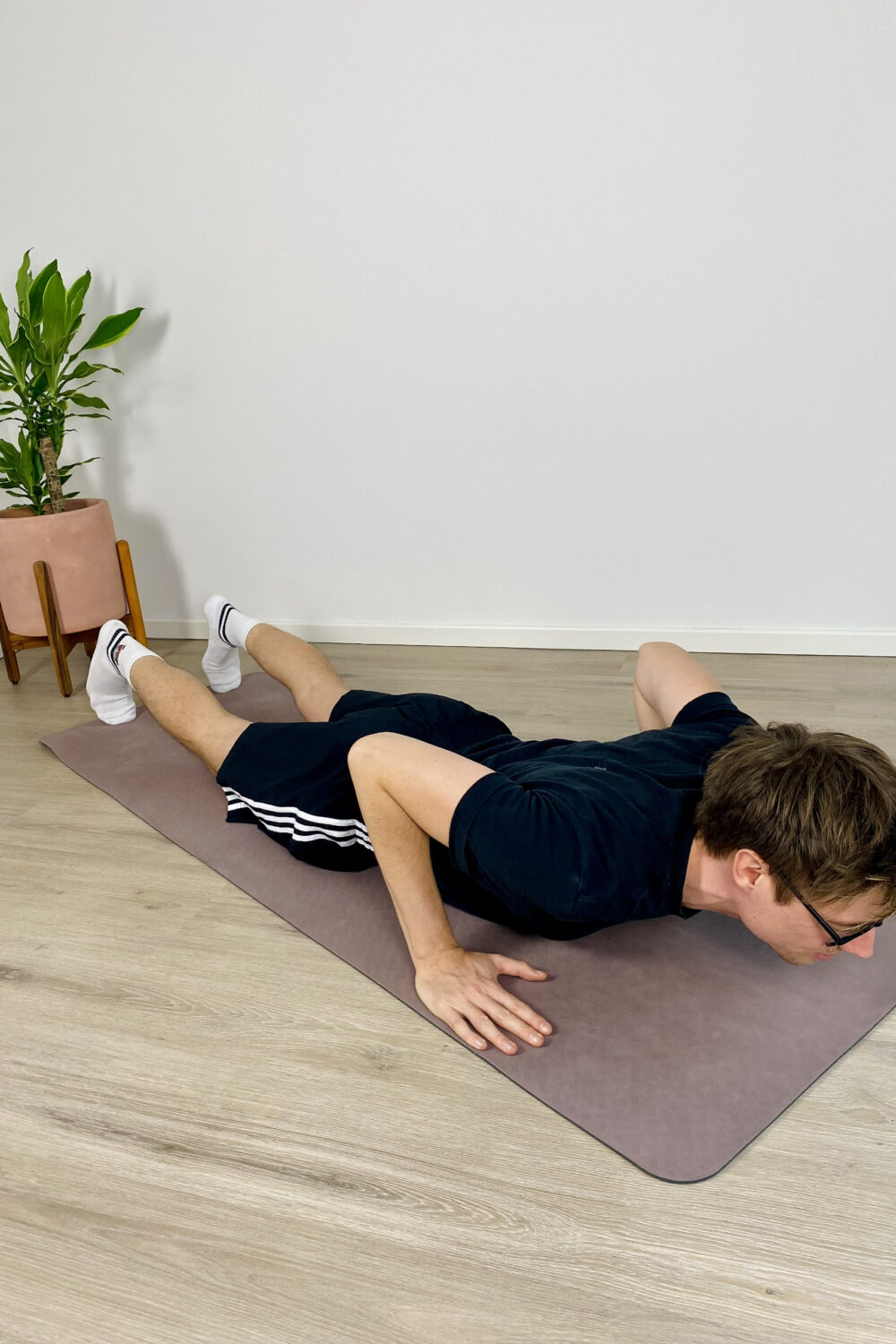

STEP 1
This is a very effective stretch for the quadriceps as you can quickly intensify the stretch with your own torso.
Go down on your knees and have your feet touch the wall behind you.
STEP 2
Put your right knee all the way up against the wall. If you are new to this, leave some space between your knee and the wall. The closer you are the deeper the stretch is.
You might want to use some kind of padding because this exercise might be uncomfortable for your knees. A cushion or a thicker yoga mat will do.
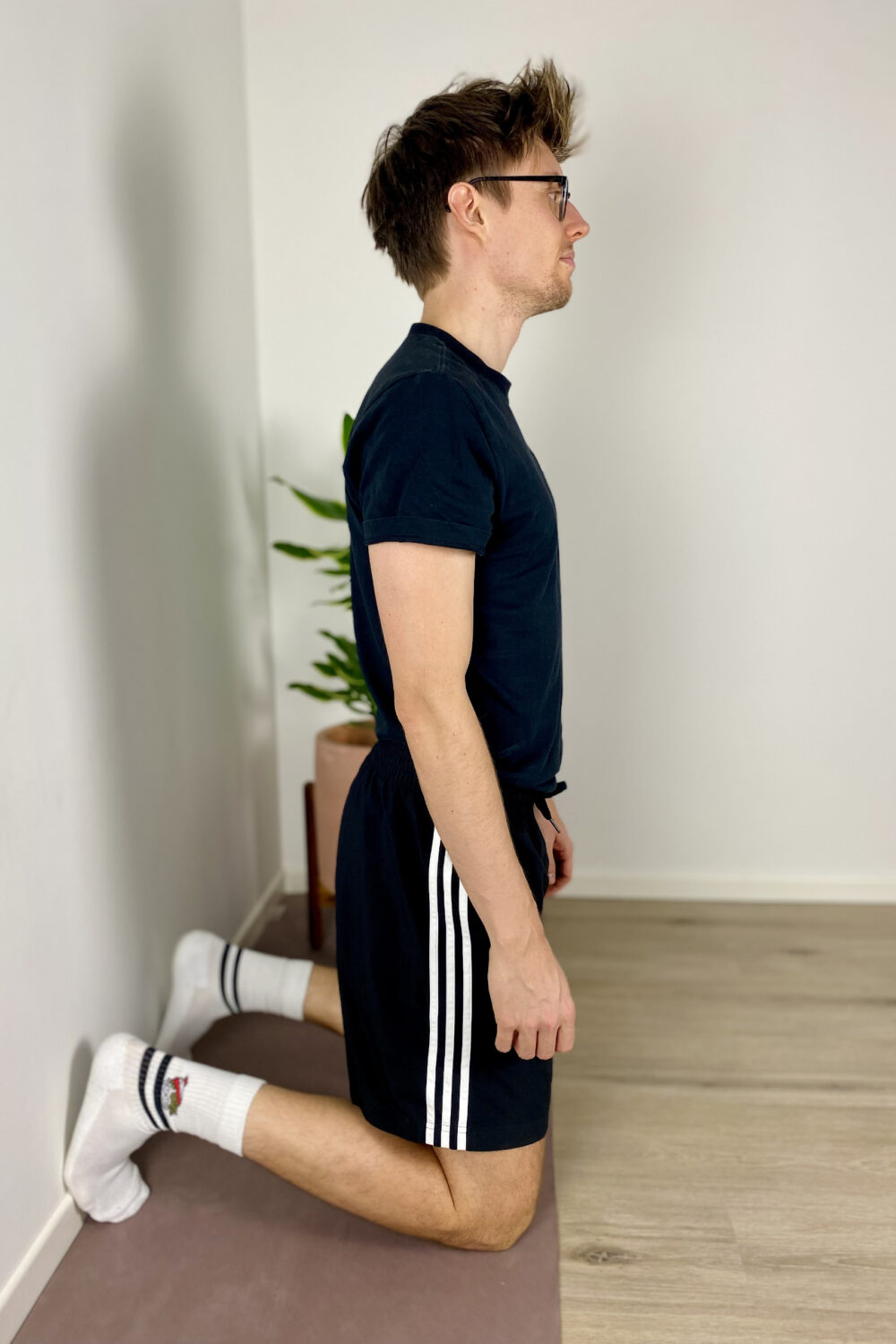
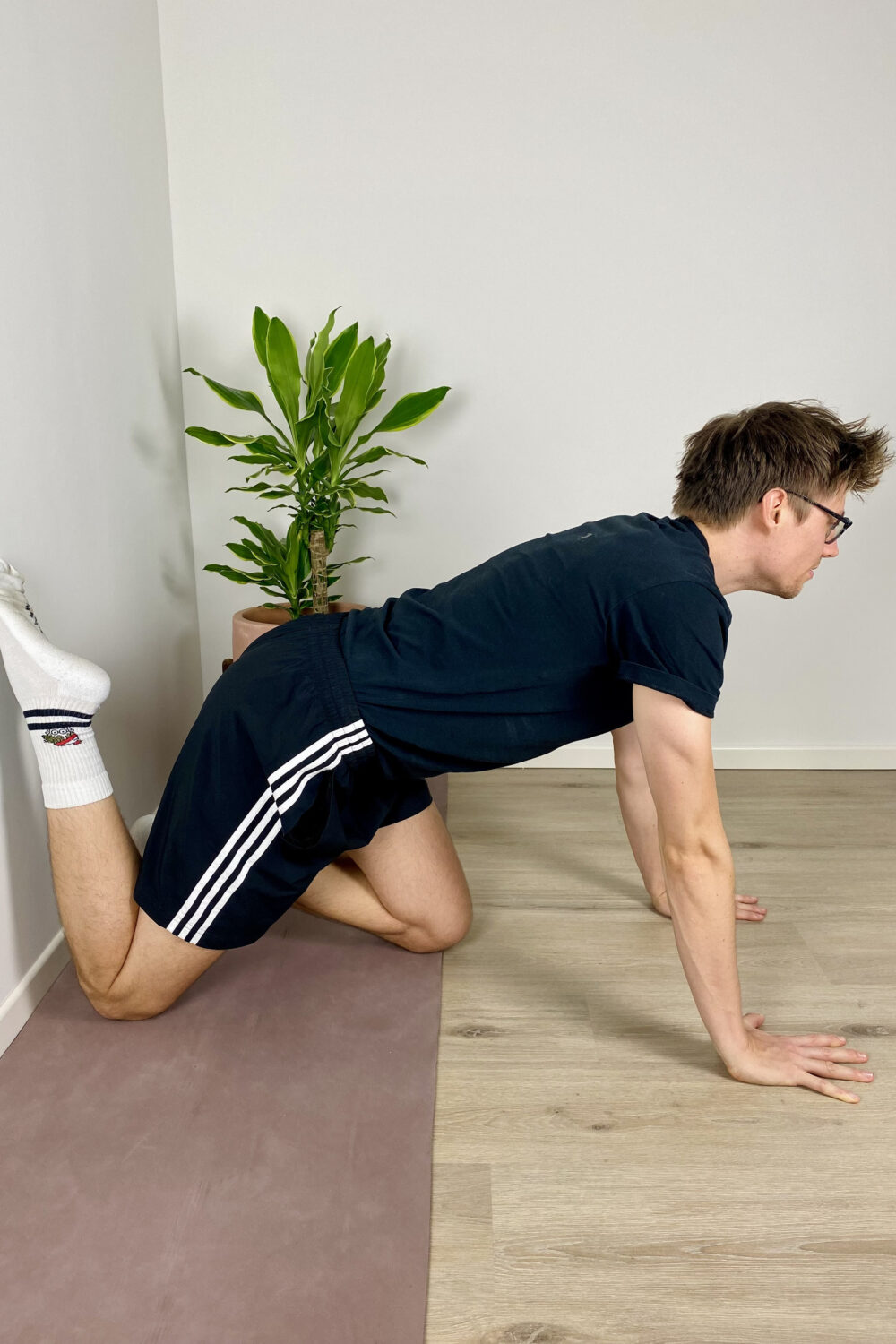
STEP 3
Bring your left knee up and you will feel how your right quadriceps starts stretching. In the beginning, you might want to stay in a low position with one hand still on the floor.
Once you feel comfortable enough, lift your torso up towards the wall.
This is a matter of flexibility. Flexible people can try straightening their torso so their back is touching the wall. If that is too much for you, lift up your torso as much as you can without feeling pain.
STEP 4
Repeat the same exercise for the other side.
You might notice that stretching one leg is easier than the other. This is not uncommon and simply shows potential for improvements in flexibility.
Stretch the weaker side longer and more often if needed.
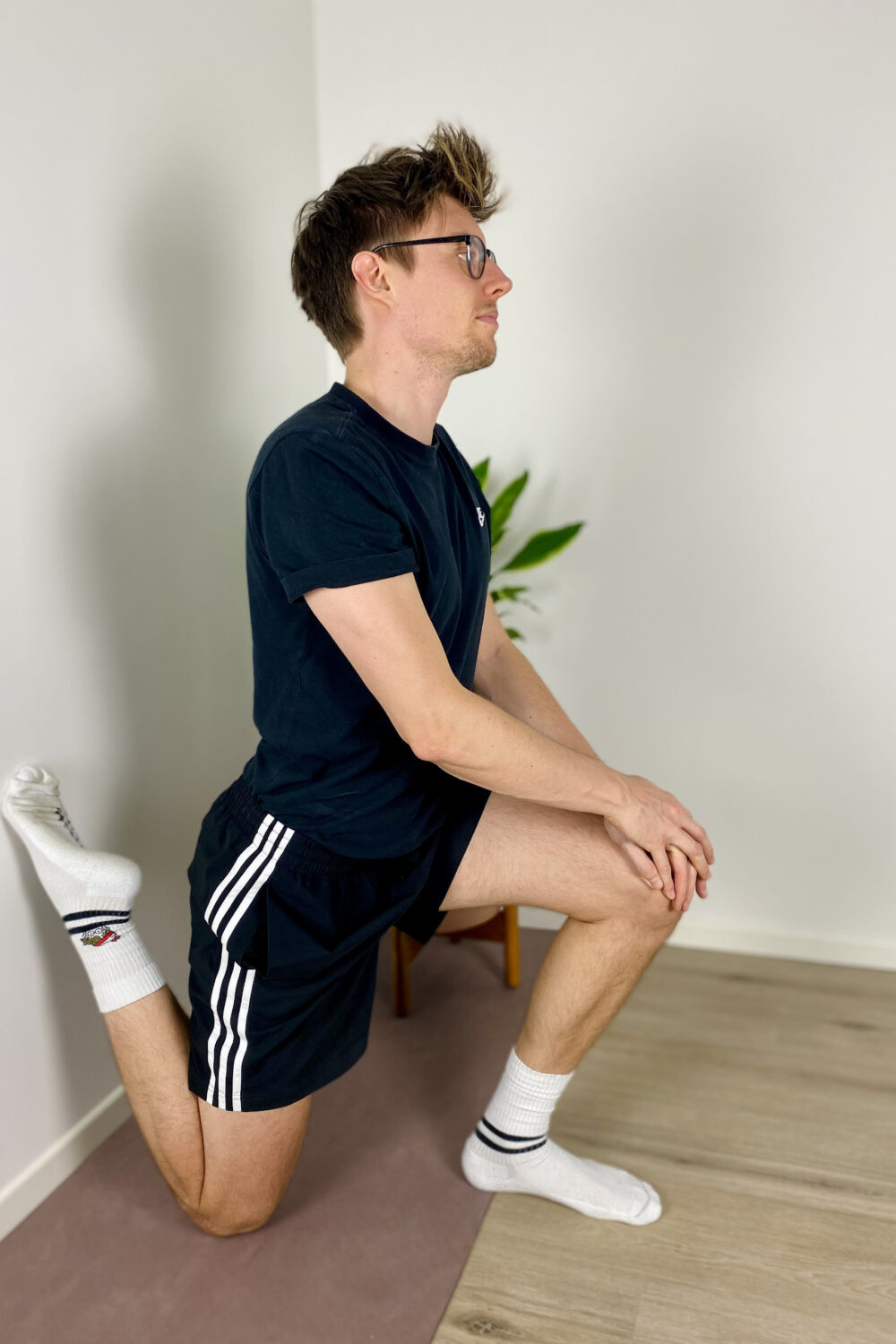
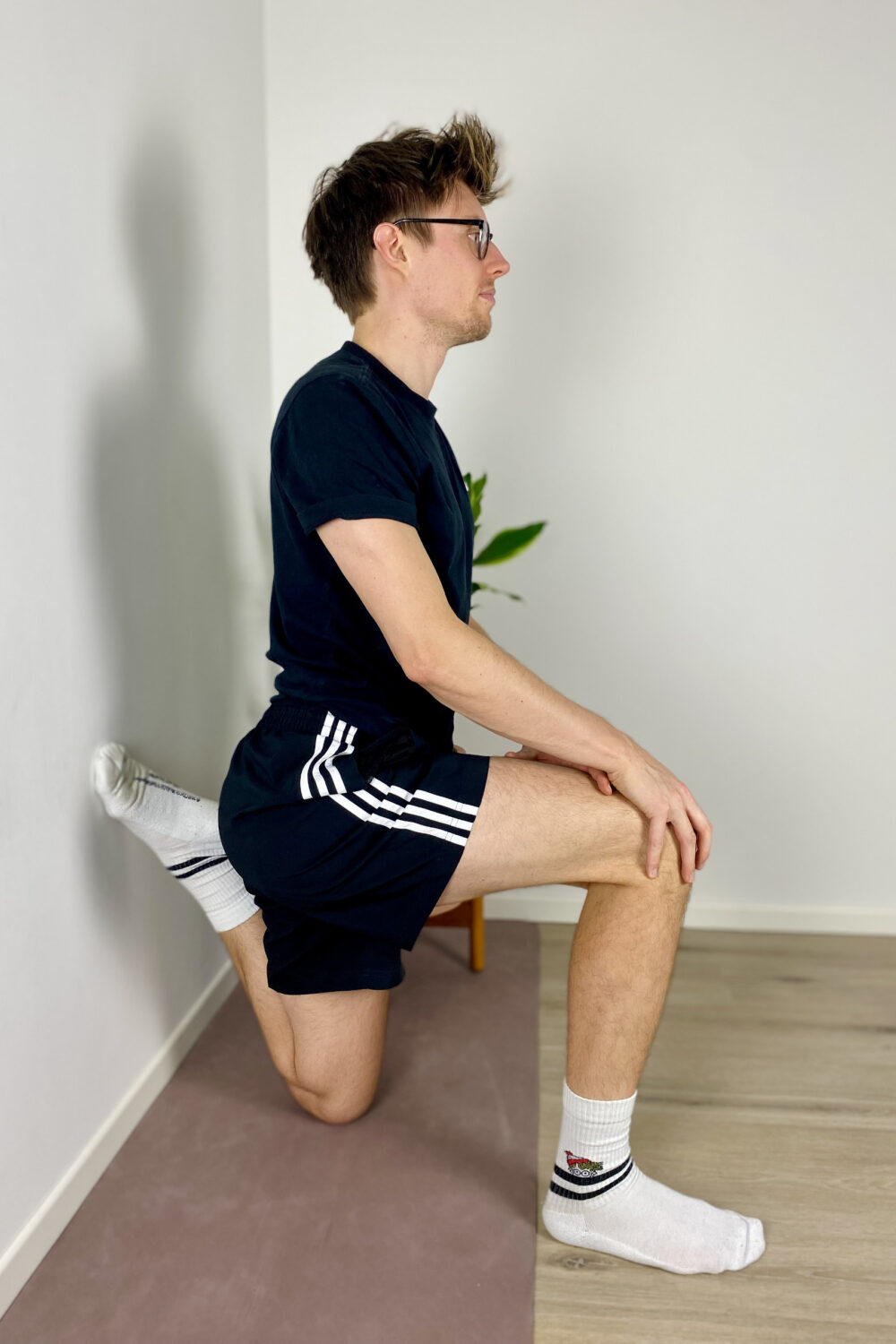
Do your legs start hurting when you walk? Does the pain wake you up in the night? Do you feel an uncomfortable sensation when sitting or lying down? All these symptoms do not necessarily mean that there is anything wrong with you or your legs. In many cases, leg pain can be treated with a few simple and easy-to-learn stretching exercises.
Even if you don’t run marathons or participate in the Tour de France, you have probably noticed what our leg muscles are capable of. They stabilize our entire body when we walk, run, jump or climb the stairs. Our legs are built for endurance and are one of the strongest muscles in our body. However, humans spend on average around 8 hours sitting per day. Not that bad you are thinking? Considering that we also need to sleep for at least another 6 hours, it is safe to say that our legs literally stand still most of the time. Naturally, this has an effect on us.
We want to explain to you why your legs hurt and what you can do about it. We also show you leg stretching exercises that can help you ease the pain.
Even though it may feel like your pain is coming from deep within your bones, tensed muscles and fascia are most likely the real cause. Our legs are exposed to high levels of tension due to repetitive movements or too little mobility in our everyday life. Particularly sitting causes symptoms such as numbness or tingling in the legs as well as knee or back pain. It may sound conflicting, but the reason for leg pain is often a lack of movement and poor posture.
Identifying the number one reason for leg pain is almost impossible. Bones, vessels, traumas, nerves, or joints often relate to leg and knee pain. Also, symptoms frequently overlap. On this site, however, we are interested in treating musculoskeletal leg pain caused by bad posture and tension. This kind of pain can often be treated with a few simple leg pain and mobility exercises in the comfort of your home. All you need is 10 minutes a day.
Many people underestimate the profound connection between poor posture and the development of leg and knee pain. Yet, the way you carry yourself can significantly influence the health of your lower extremities.
Many people underestimate the profound connection between poor posture and the development of leg and knee pain. Yet, the way you carry yourself can significantly influence the health of your lower extremities. Here is why:
Poor posture often leads to muscle imbalances. When you consistently slouch or hunch, certain muscle groups become overactive while others weaken. Over time, this imbalance can create tension in the muscles of your legs and knees, causing discomfort and pain. Try our leg pain stretching exercises to work on those imbalances and relieve the tension.
Misaligned posture can place excessive stress on the joints of your legs and knees. Your body's weight is not evenly distributed, which can lead to wear and tear on the joints, potentially resulting in conditions like osteoarthritis. Stretching and releasing tension in the joints can also affect blood flow. Increased blood circulation can boost the body's natural healing processes and contribute to pain relief.
Restless Leg Syndrome (RLS), also known as Willis-Ekbom Disease, is a neurological disorder characterized by an uncontrollable urge to move the legs. Individuals with RLS often experience uncomfortable sensations in their legs, typically described as tingling, crawling, or aching. These sensations are most pronounced when at rest, especially in the evening or at night, making it difficult to relax and fall asleep. RLS can affect one's overall quality of life due to the constant need to move the legs to find relief. Common Symptoms of Restless Leg Syndrome are:
The hallmark symptom of RLS is the presence of uncomfortable sensations in the legs. These sensations can vary from a crawling or tingling feeling to a deep ache.
RLS symptoms tend to intensify when the affected individual is at rest, such as when sitting or lying down. As a result, it can be particularly disruptive during periods of relaxation or sleep.
RLS often causes sleep disturbances, leading to fatigue and reduced daytime functioning. The frequent need to move the legs during the night can interfere with sleep patterns.
People with RLS experience an irresistible urge to move their legs to alleviate discomfort. This urge can be difficult to resist, and movement provides temporary relief.
Leg movement, such as walking or stretching, temporarily relieves the sensations associated with RLS.
Leg stretches can be a valuable part of managing RLS symptoms and providing relief. They can help with muscles relaxation, improved blood flow, enhanced sleep, stress reduction and strengthening the mind-body connection. Incorporating leg stretches into a daily routine, especially before bedtime, can contribute to better symptom management and improved sleep for individuals with Restless Leg Syndrome. However, it's essential for those with RLS to consult a healthcare professional for a comprehensive treatment plan that may include stretching exercises, medication, and lifestyle adjustments to address their specific needs.
Have you ever noticed how many 90-degree angles your body is shaping when you sit at a desk or on the sofa? Your ankles, your knees, and your hip flexor (the hip area between the thigh and the abdomen). Even your arms are resting at an almost perfect right angle.
Sitting in front of the computer or in an office chair is not a problem by itself. It only causes damage and pain when not treated properly over a longer period of time. No wonder most of us complain about stiff legs or knees that hurt.
Sitting in a compressed position and the lack of movement are the two major reasons for leg and hip pain. What happens to the body of a weightlifter when not lifting weights for some time? Their muscles dwindle because they are not being stimulated anymore.
The same happens if we sit over a longer period of time. Our muscles and fascia shorten. As a result, we experience tight hips and sore knees.
Common signs of tight hip flexors are closely connected to leg pain. In many cases, the hip flexor can cause lower back or hip pain. But why is this muscle group so crucial for our mobility?
The hip flexor originates at the spine in the lower back and is attached to the thigh bone. It is because of this muscle group that we can flex our hips and bend our knees. In other words: the hip flexor is an essential muscle for a bunch of actions like walking, sitting straight or standing up.
So with tight hip flexors, your legs aren't physically able to straighten certain muscles. Your body simply won't allow it and important muscles begin to shorten and ache. Common signs are decreased leg mobility, hip pain, knee pain, and lower back tension. Tight hip flexors are often a result of sitting, poor posture, or incorrect training.
Leg stretching exercises can relieve that tension.
Stretching is a great and easy way of treatment. The exercise program on this site contains a series of stretches that can help relieve tight hip flexors and reduce leg pain.
Find out who we are and why we think that a pain-free life is possible for everyone!